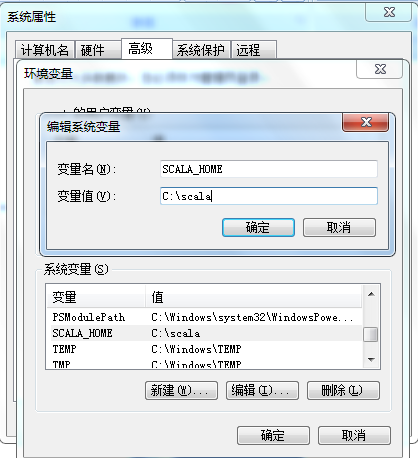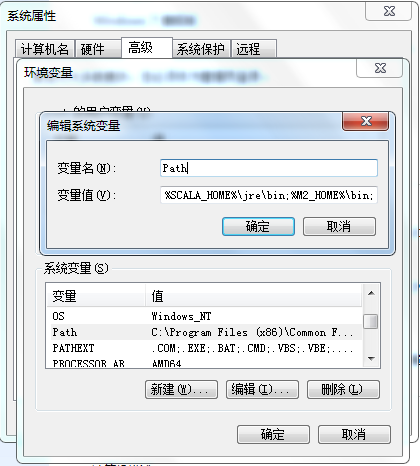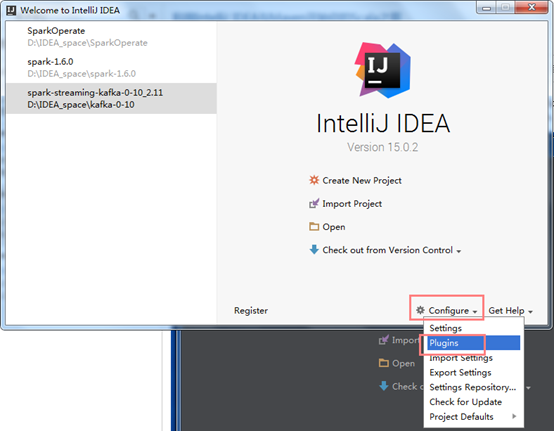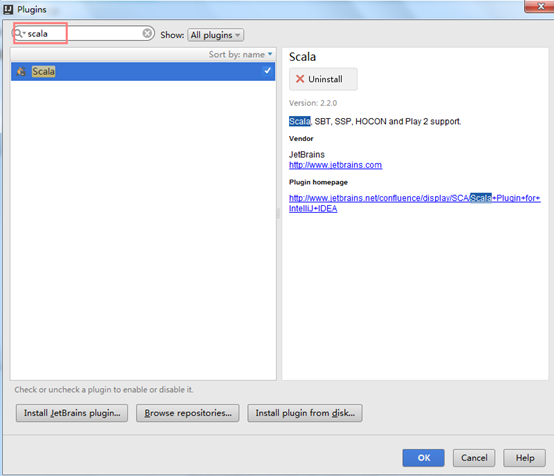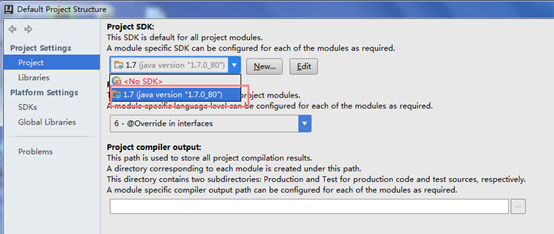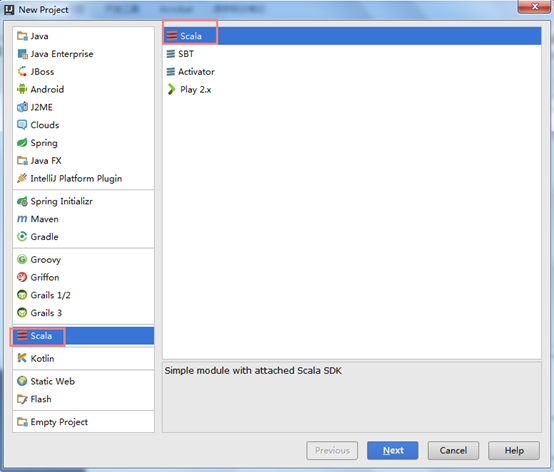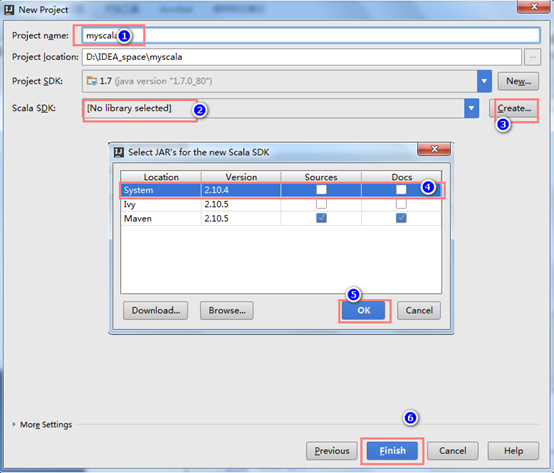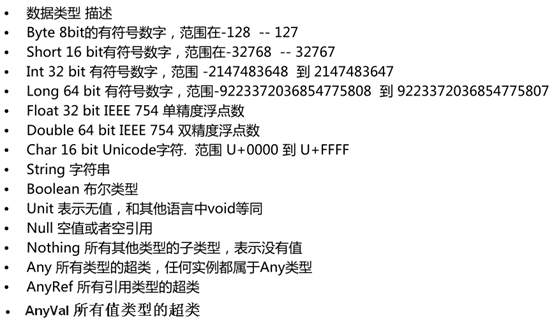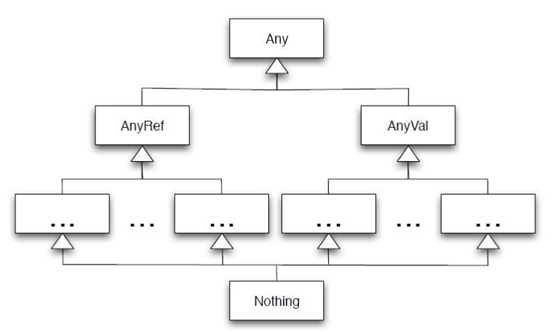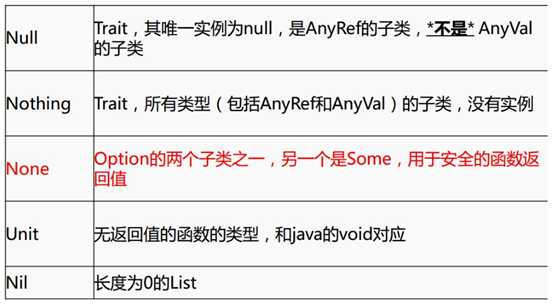Scala
Scala介绍
1.Spark中使用的是Sacla2.10。
2.Scala官网6个特征。
1).Java和scala可以混编
2).类型推测(自动推测类型)
3).并发和分布式(Actor)
4).特质,特征(类似java中interfaces 和 abstract结合)
- 官网下载scala2.10:http://www.scala-lang.org/download/2.10.4.html
- 下载好后安装。双击msi包安装,记住安装的路径。
http://scala-ide.org/download/prev-stable.html

- 下载好zip包后,解压如下:

- 将features和plugins两个文件夹拷贝到eclipse安装目录中的" dropins/scala"目录下。进入dropins,新建scala文件夹,将两个文件夹拷贝到"dropins/scala"下
/** * 定义变量和常量 * 变量 :用 var 定义 ,可修改 * 常量 :用 val 定义,不可修改 */ var name = "zhangsan" println(name) name ="lisi" println(name) val gender = "m" // gender = "m"//错误,不能给常量再赋值 |
class Person{ val name = "zhangsan" val age = 18 def sayName() = { "my name is "+ name } } |
object Lesson_Class { def main(args: Array[String]): Unit = { val person = new Person() println(person.age); println(person.sayName()) } } |
class Person(xname :String , xage :Int){ var name = Person.name val age = xage var gender = "m" def this(name:String,age:Int,g:String){ this(name,age) gender = g }
def sayName() = { "my name is "+ name }
}
object Person { val name = "zhangsanfeng"
def main(args: Array[String]): Unit = { val person = new Person("wagnwu",10,"f") println(person.age); println(person.sayName()) println(person.gender) } } |
- 建议类名首字母大写 ,方法首字母小写,类和方法命名建议符合驼峰命名法。
- scala 中的object是单例对象,相当于java中的工具类,可以看成是定义静态的方法的类。object不可以传参数。另:Trait不可以传参数
- class 类属性自带getter ,setter方法。
- 使用object时,不用new,使用class时要new ,并且new的时候,class中除了方法不执行,其他都执行。
- 如果在同一个文件中,object对象和class类的名称相同,则这个对象就是这个类的伴生对象,这个类就是这个对象的伴生类。可以互相访问私有变量。
/** * if else */ val age =18 if (age < 18 ){ println("no allow") }else if (18<=age&&age<=20){ println("allow with other") }else{ println("allow self") } |
/** * to和until * 例: * 1 to 10 返回1到10的Range数组,包含10 * 1 until 10 返回1到10 Range数组 ,不包含10 */
println(1 to 10 )//打印 1, 2, 3, 4, 5, 6, 7, 8, 9, 10 println(1.to(10))//与上面等价,打印 1, 2, 3, 4, 5, 6, 7, 8, 9, 10
println(1 to (10 ,2))//步长为2,从1开始打印 ,1,3,5,7,9 println(1.to(10, 2))
println(1 until 10 ) //不包含最后一个数,打印 1,2,3,4,5,6,7,8,9 println(1.until(10))//与上面等价
println(1 until (10 ,3 ))//步长为2,从1开始打印,打印1,4,7 |
/** * for 循环 * */ for( i <- 1 to 10 ){ println(i) } |
//可以分号隔开,写入多个list赋值的变量,构成多层for循环 //scala中 不能写count++ count-- 只能写count+ var count = 0; for(i <- 1 to 10; j <- 1 until 10){ println("i="+ i +", j="+j) count += 1 } println(count);
//例子: 打印小九九 for(i <- 1 until 10 ;j <- 1 until 10){ if(i>=j){ print(i +" * " + j + " = "+ i*j+" ")
} if(i==j ){ println() }
} |
//可以在for循环中加入条件判断 for(i<- 1 to 10 ;if (i%2) == 0 ;if (i == 4) ){ println(i) } |
- scala中不能使用count++,count—只能使用count = count+1 ,count += 1
- for循环用yield 关键字返回一个集合
- while循环,while(){},do {}while()
//将for中的符合条件的元素通过yield关键字返回成一个集合 val list = for(i <- 1 to 10 ; if(i > 5 )) yield i for( w <- list ){ println(w) }
/** * while 循环 */ var index = 0 while(index < 100 ){ println("第"+index+"次while 循环") index += 1 } index = 0 do{ index +=1 println("第"+index+"次do while 循环") }while(index <100 ) |
def fun (a: Int , b: Int ) : Unit = { println(a+b) } fun(1,1)
def fun1 (a : Int , b : Int)= a+b println(fun1(1,2)) |
- 函数定义语法 用def来定义
- 可以定义传入的参数,要指定传入参数的类型
- 方法可以写返回值的类型也可以不写,会自动推断,有时候不能省略,必须写,比如在递归函数中或者函数的返回值是函数类型的时候。
- scala中函数有返回值时,可以写return,也可以不写return,会把函数中最后一行当做结果返回。当写return时,必须要写函数的返回值。
- 如果返回值可以一行搞定,可以将{}省略不写
- 传递给方法的参数可以在方法中使用,并且scala规定方法的传过来的参数为val的,不是var的。
- 如果去掉方法体前面的等号,那么这个方法返回类型必定是Unit的。这种说法无论方法体里面什么逻辑都成立,scala可以把任意类型转换为Unit.假设,里面的逻辑最后返回了一个string,那么这个返回值会被转换成Unit,并且值会被丢弃。
/** * 递归函数 * 5的阶乘 */ def fun2(num :Int) :Int= { if(num ==1) num else num * fun2(num-1) } print(fun2(5)) |
/** * 包含默认参数值的函数 * 注意: * 1.默认值的函数中,如果传入的参数个数与函数定义相同,则传入的数值会覆盖默认值 * 2.如果不想覆盖默认值,传入的参数个数小于定义的函数的参数,则需要指定参数名称 */ def fun3(a :Int = 10,b:Int) = { println(a+b) } fun3(b=2) |
/** * 可变参数个数的函数 * 注意:多个参数逗号分开 */ def fun4(elements :Int*)={ var sum = 0; for(elem <- elements){ sum += elem } sum } println(fun4(1,2,3,4)) |
/** * 匿名函数 * 1.有参数匿名函数 * 2.无参数匿名函数 * 3.有返回值的匿名函数 * 注意: * 可以将匿名函数返回给定义的一个变量 */ //有参数匿名函数 val value1 = (a : Int) => { println(a) } value1(1) //无参数匿名函数 val value2 = ()=>{ println("我爱尚学堂") } value2() //有返回值的匿名函数 val value3 = (a:Int,b:Int) =>{ a+b } println(value3(4,4)) |
/** * 嵌套函数 * 例如:嵌套函数求5的阶乘 */ def fun5(num:Int)={ def fun6(a:Int,b:Int):Int={ if(a == 1){ b }else{ fun6(a-1,a*b) } } fun6(num,1) } println(fun5(5)) |
/** * 偏应用函数 */ def log(date :Date, s :String)= { println("date is "+ date +",log is "+ s) }
val date = new Date() log(date ,"log1") log(date ,"log2") log(date ,"log3")
//想要调用log,以上变化的是第二个参数,可以用偏应用函数处理 val logWithDate = log(date,_:String) logWithDate("log11") logWithDate("log22") logWithDate("log33") |
/** * 高阶函数 * 函数的参数是函数 或者函数的返回是函数 或者函数的参数和返回都是函数 */
//函数的参数是函数 def hightFun(f : (Int,Int) =>Int, a:Int ) : Int = { f(a,100) } def f(v1 :Int,v2: Int):Int = { v1+v2 }
println(hightFun(f, 1))
//函数的返回是函数 //1,2,3,4相加 def hightFun2(a : Int,b:Int) : (Int,Int)=>Int = { def f2 (v1: Int,v2:Int) :Int = { v1+v2+a+b } f2 } println(hightFun2(1,2)(3,4))
//函数的参数是函数,函数的返回是函数 def hightFun3(f : (Int ,Int) => Int) : (Int,Int) => Int = { f } println(hightFun3(f)(100,200)) println(hightFun3((a,b) =>{a+b})(200,200)) //以上这句话还可以写成这样 //如果函数的参数在方法体中只使用了一次 那么可以写成_表示 println(hightFun3(_+_)(200,200)) |
/** * 柯里化函数 */ def fun7(a :Int,b:Int)(c:Int,d:Int) = { a+b+c+d } println(fun7(1,2)(3,4)) |
/** * String && StringBuilder */ val str = "abcd" val str1 = "ABCD"
println(str.indexOf(97)) println(str.indexOf("b"))
println(str==str1) /** * compareToIgnoreCase * * 如果参数字符串等于此字符串,则返回值 0; * 如果此字符串小于字符串参数,则返回一个小于 0 的值; * 如果此字符串大于字符串参数,则返回一个大于 0 的值。 * */ println(str.compareToIgnoreCase(str1))
val strBuilder = new StringBuilder strBuilder.append("abc") // strBuilder.+('d') strBuilder+ 'd' // strBuilder.++=("efg") strBuilder++= "efg" // strBuilder.+=('h') strBuilder+= 'h' strBuilder.append(1.0) strBuilder.append(18f) println(strBuilder)
|
|
/** * 创建数组两种方式: * 1.new Array[String](3) * 2.直接Array */
//创建类型为Int 长度为3的数组 val arr1 = new Array[Int](3) //创建String 类型的数组,直接赋值 val arr2 = Array[String]("s100","s200","s300") //赋值 arr1(0) = 100 arr1(1) = 200 arr1(2) = 300 |
/** * 遍历两种方式 */ for(i <- arr1){ println(i) } arr1.foreach(i => { println(i) })
for(s <- arr2){ println(s) } arr2.foreach { x => println(x) }
|
/** * 创建二维数组和遍历 */ val arr3 = new Array[Array[String]](3) arr3(0)=Array("1","2","3") arr3(1)=Array("4","5","6") arr3(2)=Array("7","8","9") for(i <- 0 until arr3.length){ for(j <- 0 until arr3(i).length){ print(arr3(i)(j)+" ") } println() }
var count = 0 for(arr <- arr3 ;i <- arr){ if(count%3 == 0){ println() } print(i+" ") count +=1 }
arr3.foreach { arr => { arr.foreach { println } }}
val arr4 = Array[Array[Int]](Array(1,2,3),Array(4,5,6)) arr4.foreach { arr => { arr.foreach(i => { println(i) }) }} println("-------") for(arr <- arr4;i <- arr){ println(i) }
|
|
|
//创建 val list = List(1,2,3,4,5)
//遍历 list.foreach { x => println(x)} // list.foreach { println} //filter val list1 = list.filter { x => x>3 } list1.foreach { println}
//count val value = list1.count { x => x>3 } println(value)
//map val nameList = List( "hello bjsxt", "hello xasxt", "hello shsxt" ) val mapResult:List[Array[String]] = nameList.map{ x => x.split(" ") } mapResult.foreach{println}
//flatmap val flatMapResult : List[String] = nameList.flatMap{ x => x.split(" ") } flatMapResult.foreach { println } |
|
//创建 val set1 = Set(1,2,3,4,4) val set2 = Set(1,2,5) //遍历 //注意:set会自动去重 set1.foreach { println} for(s <- set1){ println(s) } println("*******") /** * 方法举例 */
//交集 val set3 = set1.intersect(set2) set3.foreach{println} val set4 = set1.&(set2) set4.foreach{println} println("*******") //差集 set1.diff(set2).foreach { println } set1.&~(set2).foreach { println } //子集 set1.subsetOf(set2)
//最大值 println(set1.max) //最小值 println(set1.min) println("****")
//转成数组,list set1.toArray.foreach{println} println("****") set1.toList.foreach{println}
//mkString println(set1.mkString) println(set1.mkString("\t"))
|
|
注意:创建map时,相同的key被后面的相同的key顶替掉,只保留一个
val map = Map( "1" -> "bjsxt", 2 -> "shsxt", (3,"xasxt") ) |
//获取值 println(map.get("1").get) val result = map.get(8).getOrElse("no value") println(result) |
//map遍历 for(x <- map){ println("====key:"+x._1+",value:"+x._2) } map.foreach(f => { println("key:"+ f._1+" ,value:"+f._2) }) |
//遍历key val keyIterable = map.keys keyIterable.foreach { key => { println("key:"+key+", value:"+map.get(key).get) } } println("---------")
|
//遍历value val valueIterable = map.values valueIterable.foreach { value => { println("value: "+ value) } }
|
//合并map val map1 = Map( (1,"a"), (2,"b"), (3,"c") ) val map2 = Map( (1,"aa"), (2,"bb"), (2,90), (4,22), (4,"dd") ) map1.++:(map2).foreach(println)
|
/** * map方法 */ //count val countResult = map.count(p => { p._2.equals("shsxt") }) println(countResult)
//filter map.filter(_._2.equals("shsxt")).foreach(println)
//contains println(map.contains(2))
//exist println(map.exists(f =>{ f._2.equals("xasxt")
}))
|
|
- val tuple = new Tuple(1) 可以使用new
- val tuple2 = Tuple(1,2) 可以不使用new,也可以直接写成val tuple3 =(1,2,3)
- 取值用"._XX" 可以获取元组中的值
//创建,最多支持22个 val tuple = new Tuple1(1) val tuple2 = Tuple2("zhangsan",2) val tuple3 = Tuple3(1,2,3) val tuple4 = (1,2,3,4) val tuple18 = Tuple18(1,2,3,4,5,6,7,8,9,10,11,12,13,14,15,16,17,18) val tuple22 = new Tuple22(1,2,3,4,5,6,7,8,9,10,11,12,13,14,15,16,17,18,19,20,21,22)
//使用 println(tuple2._1 + "\t"+tuple2._2) val t = Tuple2((1,2),("zhangsan","lisi")) println(t._1._2) |
//遍历 val tupleIterator = tuple22.productIterator while(tupleIterator.hasNext){ println(tupleIterator.next()) } |
/** * 方法 */ //翻转,只针对二元组 println(tuple2.swap)
//toString println(tuple3.toString()) |
Scala Trait(特征) 相当于 Java 的接口,实际上它比接口还功能强大。
一般情况下Scala的类可以继承多个Trait,从结果来看就是实现了多重继承。Trait(特征) 定义的方式与类类似,但它使用的关键字是 trait。
trait Read { val readType = "Read" val gender = "m" def read(name:String){ println(name+" is reading") } }
trait Listen { val listenType = "Listen" val gender = "m" def listen(name:String){ println(name + " is listenning") } }
class Person() extends Read with Listen{ override val gender = "f" }
object test { def main(args: Array[String]): Unit = { val person = new Person() person.read("zhangsan") person.listen("lisi") println(person.listenType) println(person.readType) println(person.gender)
} } |
object Lesson_Trait2 { def main(args: Array[String]): Unit = { val p1 = new Point(1,2) val p2 = new Point(1,3) println(p1.isEqule(p2)) println(p1.isNotEqule(p2)) } }
trait Equle{ def isEqule(x:Any) :Boolean def isNotEqule(x : Any) = { !isEqule(x) } }
class Point(x:Int, y:Int) extends Equle { val xx = x val yy = y
def isEqule(p:Any) = { p.isInstanceOf[Point] && p.asInstanceOf[Point].xx==xx }
} |
一个模式匹配包含了一系列备选项,每个都开始于关键字 case。
每个备选项都包含了一个模式及一到多个表达式。箭头符号 => 隔开了模式和表达式。
object Lesson_Match { def main(args: Array[String]): Unit = { val tuple = Tuple6(1,2,3f,4,"abc",55d) val tupleIterator = tuple.productIterator while(tupleIterator.hasNext){ matchTest(tupleIterator.next()) }
} /** * 注意点: * 1.模式匹配不仅可以匹配值,还可以匹配类型 * 2.模式匹配中,如果匹配到对应的类型或值,就不再继续往下匹配 * 3.模式匹配中,都匹配不上时,会匹配到 case _ ,相当于default */ def matchTest(x:Any) ={ x match { case x:Int=> println("type is Int") case 1 => println("result is 1") case 2 => println("result is 2") case 3=> println("result is 3") case 4 => println("result is 4") case x:String => println("type is String") // case x :Double => println("type is Double") case _ => println("no match") } }
} |
case class Person1(name:String,age:Int)
object Lesson_CaseClass { def main(args: Array[String]): Unit = { val p1 = new Person1("zhangsan",10) val p2 = Person1("lisi",20) val p3 = Person1("wangwu",30)
val list = List(p1,p2,p3) list.foreach { x => { x match { case Person1("zhangsan",10) => println("zhangsan") case Person1("lisi",20) => println("lisi") case _ => println("no match") } } }
} } |
spark1.6版本之前,spark分布式节点之间的消息传递使用的就是Akka,底层也就是actor实现的。1.6之后使用的netty传输。
import scala.actors.Actor
class myActor extends Actor{
def act(){ while(true){ receive { case x:String => println("save String ="+ x) case x:Int => println("save Int") case _ => println("save default") } } } }
object Lesson_Actor { def main(args: Array[String]): Unit = {
//创建actor的消息接收和传递 val actor =new myActor() //启动 actor.start() //发送消息写法 actor ! "i love you !"
} } |
case class Message(actor:Actor,msg:Any)
class Actor1 extends Actor{ def act(){ while(true){ receive{ case msg :Message => { println("i sava msg! = "+ msg.msg)
msg.actor!"i love you too !" } case msg :String => println(msg) case _ => println("default msg!") } } } }
class Actor2(actor :Actor) extends Actor{ actor ! Message(this,"i love you !") def act(){ while(true){ receive{ case msg :String => { if(msg.equals("i love you too !")){ println(msg) actor! "could we have a date !" } } case _ => println("default msg!") } } } }
object Lesson_Actor2 { def main(args: Array[String]): Unit = { val actor1 = new Actor1() actor1.start() val actor2 = new Actor2(actor1) actor2.start() } } |
import org.apache.spark.SparkConf import org.apache.spark.SparkContext import org.apache.spark.rdd.RDD import org.apache.spark.rdd.RDD.rddToPairRDDFunctions
object WordCount { def main(args: Array[String]): Unit = { val conf = new SparkConf() conf.setMaster("local").setAppName("WC") val sc = new SparkContext(conf) val lines :RDD[String] = sc.textFile("./words.txt") val word :RDD[String] = lines.flatMap{lines => { lines.split(" ") }} val pairs : RDD[(String,Int)] = word.map{ x => (x,1) } val result = pairs.reduceByKey{(a,b)=> {a+b}} result.sortBy(_._2,false).foreach(println)
//简化写法 lines.flatMap { _.split(" ")}.map { (_,1)}.reduceByKey(_+_).foreach(println)
} } |

